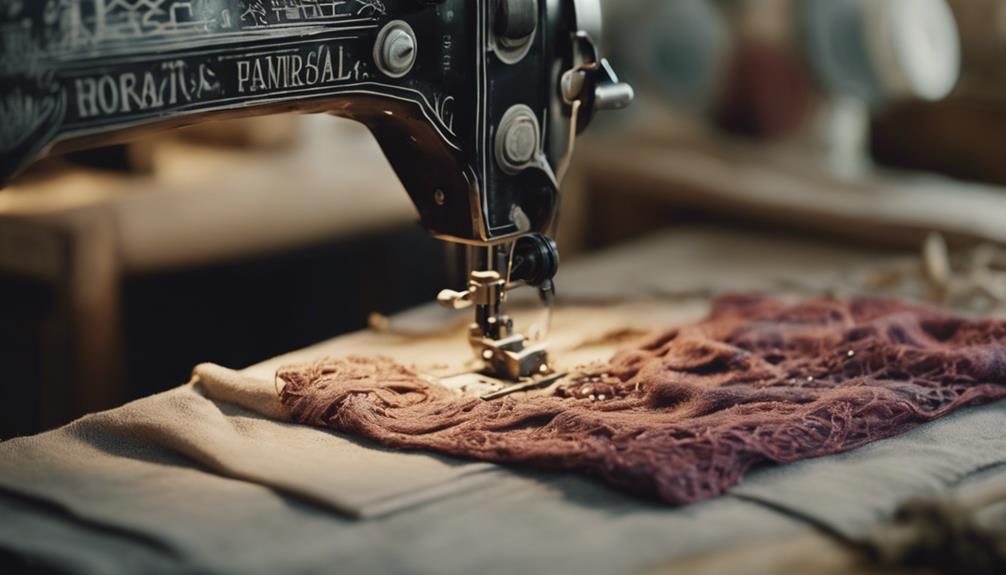Sustainable fashion comes with a higher price tag because it prioritizes ethical labor practices and utilizes high-quality materials. Many sustainable brands emphasize fair wages and safe working conditions for their employees, leading to increased production costs. Additionally, these brands produce items in limited quantities to prevent overproduction, which further drives up prices. Moreover, materials such as organic cotton and Tencel are more expensive due to their intensive production processes. Although the initial cost may be higher, these garments tend to last longer, offering better value in the long run. Interested in learning more about how these factors impact the industry and upcoming trends? Stay tuned for more insights!
Key Takeaways
- Sustainable fashion prioritizes fair wages and safe working conditions, increasing costs compared to fast fashion's exploitative labor practices.
- Production in smaller quantities minimizes overproduction, leading to higher costs per item.
- High-quality, durable materials like organic cotton and linen significantly raise production costs.
- Sustainable brands invest in ethical practices and worker well-being, reflecting higher prices on garments.
Economic Factors Driving Prices
Sustainable fashion often costs more due to the commitment to fair wages and safe working conditions for workers, unlike the cheap labor used in fast fashion. When you choose sustainable brands, you're supporting a model that prioritizes ethical practices over mass production.
These brands often produce garments in small quantities to minimize overproduction, which naturally leads to higher production costs per item.
Additionally, sustainable materials like organic cotton require more time and resources to cultivate, making them 25%-30% pricier than their synthetic alternatives. This investment in quality materials reflects the sustainable brands' dedication to ethical practices, ultimately increasing the final price you pay.
While it may seem steep at first, remember that the demand for sustainable fashion is growing. With this increased interest, there's potential for prices to stabilize or even decrease in the future.
However, the initial investment is essential for fostering ethical practices and supporting workers in the industry. By understanding these economic factors, you can appreciate the value behind sustainable fashion and the positive impact your choices can have on the environment and the lives of those who create your clothing.
Labor Practices and Fair Wages

When you consider the true cost of clothing, fair wages for workers become essential.
Many fast-fashion brands exploit labor practices, leaving only a fraction of garment workers earning a living wage.
In contrast, sustainable brands prioritize ethical practices, ensuring that workers receive fair compensation, even if it means higher prices for consumers.
Fair Wage Importance
Fair wages are essential for lifting garment workers out of poverty and ensuring they can support their families with dignity. Unfortunately, only 2% of garment workers globally earn a living wage, which highlights the urgent need for change. When you choose ethical fashion, you're not just buying clothes; you're supporting a movement that values workers' rights.
Consider the impact of fair wages on:
- Worker Well-being: Fair wages allow workers to afford basic necessities, leading to healthier families and communities.
- Economic Stability: When workers earn a decent income, they can invest in education and local economies, breaking the cycle of poverty.
- Quality Products: Ethical brands prioritize fair wages, often resulting in higher-quality garments that last longer, reducing waste.
Exploitative Labor Practices
Exploitative labor practices in the fashion industry undermine workers' rights and perpetuate poverty, revealing the stark reality behind low-priced clothing. Only 2% of garment workers globally earn a living wage, which starkly contrasts with the ethical standards upheld by sustainable fashion brands. Fast-fashion companies allocate around 70% of garment costs to fabric, leaving barely enough for fair wages. This drives down labor costs at the expense of workers' rights, making low-priced items come with a high human cost.
Sustainable fashion brands, in contrast, prioritize ethical labor practices. They often pay wages that exceed legal requirements, leading to higher garment prices. For instance, the Able T-shirt is priced at $48 due to its fair trade practices. These brands focus on producing small quantities to avoid overproduction, which considerably increases costs compared to the bulk manufacturing discounts enjoyed by their fast-fashion counterparts.
As you shop, remember that every purchase matters. Supporting sustainable fashion means choosing brands that value fair wages and decent working conditions. By doing so, you can help combat exploitative labor practices and promote a more ethical fashion industry.
Quality of Materials Used

Sustainable fashion brands focus on using high-quality, durable natural fibers that often come at a higher cost than conventional synthetic materials. Unlike fast fashion companies, which rely heavily on cheaper, synthetic fabrics, sustainable clothing emphasizes the quality of materials used.
This commitment to better materials means you'll encounter:
- Organic Cotton – Soft, breathable, and grown without harmful pesticides, making it healthier for you and the planet.
- Linen – Made from flax, it's not only biodegradable but also incredibly durable, lasting for years with proper care.
- Tencel – Produced from sustainably sourced wood, this fiber is gentle on the skin and has a lower environmental impact.
The production of these organic materials requires more time and resources, reflecting in the price. While it may seem steep at first, investing in sustainable clothing translates to long-term savings.
These garments typically last longer and withstand wear and tear better than those from fast fashion alternatives. By choosing sustainable options, you're not just making a fashion statement; you're supporting ethical practices and a healthier planet.
Consumer Perception and Demand

When you think about sustainable fashion, you might see it as pricier than fast fashion, even though those costs often reflect better materials and fair labor practices.
Many consumers want to support ethical brands, yet they still hope for lower prices, highlighting a gap between their values and spending habits.
As demand for sustainable options grows, understanding this perceived value versus actual quality becomes essential for both buyers and brands.
Perceived Value of Sustainability
Many consumers view sustainable fashion as a luxury, often associating higher prices with ethical production and quality materials. This perception is influenced by a few key factors in the fashion industry:
- Ethical labor practices: Sustainable brands often pay fair wages, exceeding legal requirements, which adds to garment costs. For example, an Able T-shirt priced at $48 reflects these fair trade principles.
- Quality materials: Unlike fast fashion, which relies heavily on cheaper synthetic fabrics, sustainable options use durable, natural materials that may cost more to source and produce.
- Limited production: Many sustainable brands operate on a smaller scale, resulting in higher per-item costs due to less mass production.
Although there's a growing awareness of environmental impacts and a shift towards sustainable options, many consumers still associate lower prices with fast fashion, creating a challenge.
This contradiction in perception makes it difficult for ethical brands to gain widespread acceptance. Ultimately, understanding the perceived value of sustainability can help you appreciate why these garments come with a higher price tag.
Price Vs. Quality Perception
Consumers often struggle to reconcile the higher prices of ethical fashion with their expectations of quality, leading to a complex relationship between price perception and perceived value.
When you see sustainable fashion items, you might notice that their prices are considerably higher than fast fashion counterparts. This can be attributed to the commitment to fair wages and environmentally friendly materials, which naturally raises production costs.
Fast fashion brands benefit from bulk manufacturing, keeping their prices low, while sustainable brands often produce in smaller quantities to minimize overproduction. This results in higher costs per garment.
However, investing in quality clothing from ethical brands often pays off in the long run. Cost-per-wear analysis shows that sustainably made items tend to last longer, reducing the need for frequent replacements.
While the initial price tag might feel intimidating, remember that ethical brands prioritize fair labor practices and quality materials. This investment in sustainable fashion not only supports fair wages but also contributes to a more responsible industry.
As consumer demand for ethical options increases, there's potential for price reductions in the future, making sustainable fashion more accessible to you.
Demand for Ethical Options
A growing number of shoppers are keen to embrace sustainable fashion, yet they often struggle with the perceived costs associated with ethical brands. While you might appreciate the values behind these brands, it's tough to justify spending more when fast fashion feels so accessible.
However, consider the benefits of choosing sustainable options:
- Workers' Fair Wages: Supporting brands that prioritize fair compensation guarantees that the people making your clothes are treated justly.
- Quality Materials: Ethical brands often use high-quality, organic cotton and other sustainable fabrics that last longer than typical fast fashion items.
- Environmental Impact: Investing in sustainable fashion means you're contributing to less waste and a healthier planet, which is a win for everyone.
As consumer awareness of the human and environmental costs of fast fashion grows, the demand for these ethical options continues to rise. If brands can address the price barrier, you might find it easier to align your spending with your values.
Ultimately, embracing sustainable fashion isn't just about style; it's a choice that reflects your commitment to a better world.
Industry Trends and Challenges

Sustainable fashion is gaining traction, yet it still grapples with the entrenched fast fashion model that prioritizes speed and cost over environmental responsibility. Major brands have adopted strategies that focus on quick production and low prices, often sidelining ethical practices. This creates a significant challenge for sustainable brands that advocate for responsible production and fair treatment of garment workers. These brands often face higher production costs due to the ethical materials and labor practices they emphasize.
The industry is marked by systemic inefficiencies, leading to overproduction and waste, which raises serious environmental and ethical concerns. While ethical fashion advocates push for transparency and accountability, many consumers still view sustainable options as expensive compared to fast fashion alternatives. This misconception hampers broader acceptance and market growth.
However, the rise of sustainable brands indicates a potential shift in consumer values. As awareness grows, you might start recognizing the value in ethical fashion, which not only supports garment workers but also contributes to a healthier planet.
The challenge remains to educate consumers about the long-term benefits of sustainable choices, fostering a culture that prioritizes quality and responsibility over mere affordability. This requires a concerted effort from educators, businesses, and policymakers to highlight the profound impact that mindful consumption can have on both the planet and future generations. By integrating practical approaches, such as budgetfriendly construction tips, individuals can see that sustainable living doesn’t have to be prohibitively expensive. Empowering consumers with accessible knowledge and resources will be key to driving this cultural shift toward sustainability.
The Future of Sustainable Fashion

As awareness of environmental impacts grows, the future of fashion looks set to embrace ethical practices and innovative materials that prioritize both people and the planet. You can expect to see a transformative shift in the industry, driven by consumer demand for transparency and responsibility.
Here are three key developments on the horizon:
- Sustainable Materials: Brands will increasingly use organic cotton, recycled polyester, and other eco-friendly alternatives, reducing their carbon footprint and reliance on harmful resources.
- Enhanced Working Conditions: Companies that prioritize fair labor practices will stand out, as consumers seek brands that guarantee safe and equitable working environments for all workers.
- Technological Integration: The rise of data tracking and digital platforms will promote circular economy principles, making it easier for you to understand the lifecycle of your purchases.
As you embrace sustainable fashion, the demand for affordable, ethical options will likely drive economies of scale, potentially lowering prices over time.
With these advancements, the future of fashion not only looks promising but also aligns with your values for a healthier planet.
Frequently Asked Questions
Why Is Sustainable Fashion Unaffordable?
Sustainable fashion's often unaffordable because it prioritizes quality, ethical labor, and eco-friendly materials. These choices lead to higher production costs, smaller batches, and fair wages, making it pricier compared to mass-produced fast fashion options.
Why Is Sustainable Clothing More Expensive?
Sustainable clothing's higher price comes from using premium materials, ethical labor practices, and smaller production runs. You're investing in quality, fairness, and the environment, which ultimately leads to a more meaningful and responsible wardrobe choice.
What Is the Problem With Sustainable Fashion?
The problem with sustainable fashion often lies in its accessibility and price. You might find it challenging to locate affordable options, as many brands prioritize quality and ethics, which can limit choices for conscious consumers like you.
Is Sustainable Fashion for the Rich?
You might think sustainable fashion's only for the rich, but that's not true. With creativity, thrift shopping, and DIY options, you can embrace eco-friendly styles without breaking the bank. Quality and ethics can be affordable.
Conclusion
To sum up, while sustainable fashion may seem pricey, it reflects the true cost of ethical production and quality materials. Investing in sustainable fashion is not only a commitment to the environment and ethical labor practices, but it is also an investment in the long-term sustainability of the fashion industry. With growing consumer awareness and demand for sustainable products, there is a potential for sustainable fashion profitability in the future. As more companies embrace sustainable practices and consumers prioritize ethical fashion, the profitability of sustainable fashion will continue to grow. By considering the true cost of ethical production and the long-term benefits of sustainability, the higher initial price of sustainable fashion becomes a worthwhile investment for both consumers and the industry as a whole.
Did you know that 60% of consumers are willing to pay more for sustainable brands? This shows a growing awareness and demand for fashion that respects both people and the planet.
By choosing sustainable options, you're not just investing in your wardrobe; you're supporting a movement towards a more responsible and environmentally-friendly industry.
Your choices really do matter!









